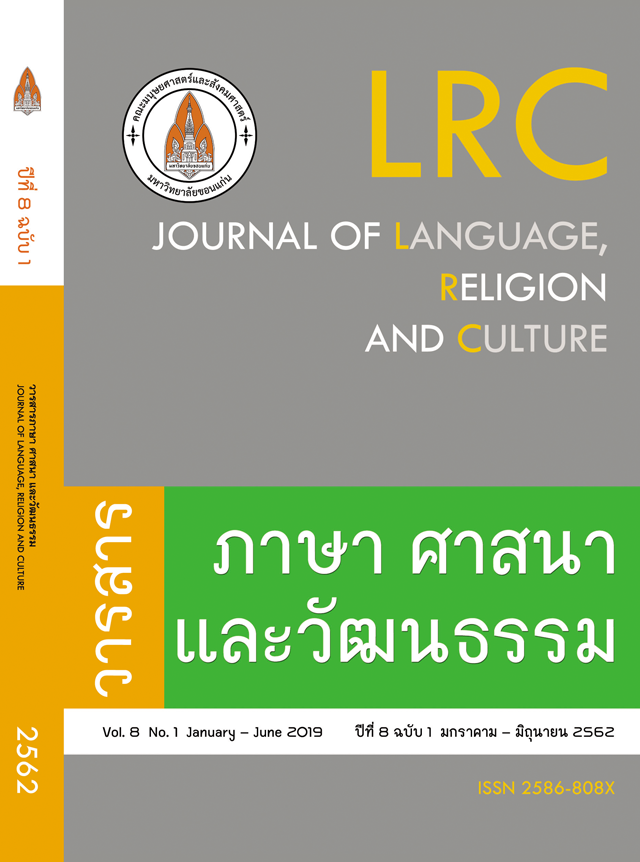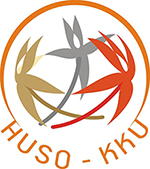การบูรณาการภาษาอังกฤษและเนื้อหาวิชาในการจัดการการท่องเที่ยวเชิงวัฒนธรรมสำหรับนักเรียนชั้นมัธยมศึกษาตอนปลาย อำเภอเชียงดาว จังหวัดเชียงใหม่; Integrating English with Content in Teaching Cultural Tourism Management to Secondary School Students in Amphur Chiang Dao, ChiangMai
Keywords:
การท่องเที่ยวเชิงวัฒนธรรม, ภาษาอังกฤษเพื่อการท่องเที่ยว, การสอนภาษาโดยใช้เนื้อหาเพื่อนำไปสู่การเรียนรู้ภาษา, Cultural Attraction, English for Tourism, Content-Based InstructionAbstract
งานวิจัยในครั้งนี้มีวัตถุประสงค์เพื่อ 1) เพื่อพัฒนาบทเรียนภาษาอังกฤษที่มีการบูรณาการภาษาอังกฤษและเนื้อหาวิชาในการจัดการการท่องเที่ยวเชิงวัฒนธรรม และ 2) เพื่อเปรียบเทียบความสามารถทางด้านการฟัง-พูดภาษาอังกฤษของนักเรียนมัธยมศึกษาตอนปลายก่อนและหลังการเรียนโดยใช้บทเรียนที่มีการบูรณาการภาษาอังกฤษและเนื้อหาวิชาในการจัดการการท่องเที่ยวเชิงวัฒนธรรม โดยกลุ่มตัวอย่างในการวิจัยครั้งนี้ คือ นักเรียนชั้นมัธยมศึกษาปีที่ 4 โรงเรียนเชียงดาววิทยาคม อำเภอเชียงดาว จังหวัดเชียงใหม่ ที่ลงทะเบียนเรียนวิชาภาษาอังกฤษพื้นฐาน (อ 41101) ในภาคเรียนที่ 2 ปีการศึกษา 2560 จำนวน 68 คน เครื่องมือที่ใช้ในการรวบรวมข้อมูลประกอบไปด้วย แบบสอบถามความต้องการและความสนใจของนักเรียนในการเรียนวิชาภาษาอังกฤษ แบบประเมินประสิทธิภาพของบทเรียนภาษาอังกฤษที่เน้นเนื้อหาการท่องเที่ยวเชิงวัฒนธรรม และแบบประเมินความสามารถทางการฟัง-พูดภาษาอังกฤษ และเครื่องมือที่ใช้ในการทดลองได้แก่ หลักสูตรแม่แบบ (Proto-Syllabus) และแผนการสอนที่เน้นเนื้อหาการท่องเที่ยวเชิงวัฒนธรรมจำนวน 8 แผน
ผลการวิจัยพบว่าบทเรียนภาษาอังกฤษที่เน้นเนื้อหาวิชาในการจัดการการท่องเที่ยวเชิงวัฒนธรรมที่มีแผนการสอนเกี่ยวกับไทใหญ่ อีก้อและกะเหรี่ยงมีความเหมาะสมอยู่ในระดับมากที่สุด และบทเรียนภาษาอังกฤษที่เน้นเนื้อหาวิชาในการจัดการการท่องเที่ยวเชิงวัฒนธรรมที่มีแผนการสอนเกี่ยวกับอำเภอเชียงดาว สถานที่ท่องเที่ยว ลีซอ มูเซอ และคะฉิ่นมีความเหมาะสมอยู่ในระดับมาก ซึ่งส่งผลให้ความสามารถในการฟังและพูดของนักเรียนผ่านเกณฑ์ร้อยละ 50 ขึ้นไป หลังจากที่ได้นำบทเรียนภาษาอังกฤษดังกล่าวมาใช้เป็นเครื่องมือในการทดลอง พบว่า นักเรียนทุกคนสอบผ่านเกณฑ์ขั้นต่ำที่กำหนดคือร้อยละ 50 นักเรียนที่ได้คะแนนรวมร้อยละ 70 ขึ้นไปมีจำนวน 10 คน คิดเป็นร้อยละ 14.71 ของนักเรียนทั้งหมด นักเรียนที่ได้คะแนนรวมร้อยละ 80 ขึ้นไปมีจำนวนทั้งหมด 50 คน คิดเป็นร้อยละ 73.53 ของนักเรียนทั้งหมด และนักเรียนที่ได้คะแนนรวมร้อยละ 90 ขึ้นไปมีจำนวนทั้งหมด 8 คน คิดเป็นร้อยละ 11.76 สำหรับความสามารถทางด้านทักษะการฟัง ส่วนความสามารถทางด้านทักษะการพูด นักเรียนทุกคนสอบผ่านเกณฑ์ขั้นต่ำที่กำหนดคือร้อยละ 50 เช่นกันโดยนักเรียนที่ได้คะแนนรวมร้อยละ 60 ขึ้นไปมีจำนวน 2 คน คิดเป็นร้อยละ 2.94 ของนักเรียนทั้งหมด นักเรียนที่ได้คะแนนรวมร้อยละ 70 ขึ้นไปมีจำนวน 52 คนคิดเป็นร้อยละ 76.47 ของนักเรียนทั้งหมด และนักเรียนที่ได้คะแนนรวมร้อยละ 80 ขึ้นไปมีจำนวน 14 คน คิดเป็นร้อยละ 20.59 ของนักเรียนทั้งหมด นอกจากนั้นผลการเปรียบเทียบคะแนนความสามารถทักษะด้านการฟัง-พูดภาษาอังกฤษของนักเรียนก่อนและหลังการใช้บทเรียนที่เนื้อหาวิชาในการจัดการการท่องเที่ยวเชิงวัฒนธรรม พบว่าความสามารถด้านการฟังภาษาอังกฤษของนักเรียนหลังเรียนสูงกว่าก่อนเรียนอยู่ในระดับดีมาก และความสามารถด้านการพูดภาษาอังกฤษของนักเรียนหลังเรียนสูงกว่าก่อนเรียนอยู่ในระดับดี
Abstract
The objectives of this research were to construct the English lessons with the integration of English and cultural tourism management content and to compare speaking and listening abilities of the students before and after the implementation of the lessons. The sample group consisted of 68 tenth grade students at Chiang Dao Withayakhom School, Chiang Mai, who enrolled in the Basic English Course (E 41101) in the second semester of the 2017 academic year. The research instruments included a questionnaire on needs and interests in studying English of the students, an assessment on the efficiency of the lessons, and an assessment on speaking and listening abilities of the students. The experiment instruments were the proto-syllabus and eight lesson plans.
The research findings revealed that the lesson plans of the lessons about Shan, Akha, and Karen were appropriate at the highest level, while the lessons about Chiang Dao district, Tourist attractions, Lisu, Lahu and Kachin were appropriate at the high level. The suitability of the lesson plans enabled the students to pass the 50-percent criterion on their listening and speaking abilities. After the implementation of the lessons, it is found that all students passed the minimum criterion of 50 percent. Ten of them, or 14.71%, received the total scores of over 70%, 50 of them, or 73.53% received the total scores of over 80%, and eight of them, or 11.76%, received the total scores of over 90%. For their listening and speaking abilities, all of them passed the minimum criterion of 50%. Two students, or 2.94%, received the total scores of over 60%, 52 of them, or 76.47%, received the total scores of over 70%, and 14 of them, or 20.59%, received the total scores of over 80%. When the pre- and posttest scores on their listening and speaking abilities were compared, it is found that their listening posttest scores were at the highest level, and their speaking posttest scores were at the high level.
References
Brinton, D., Snow, M., and Wesche, M. (2003). Content-based second language instruction. Boston: Heinle & Heinle.
Chamot, A. U., & O’ Malley, J. M. (1994). The CALLA handbook: Implementing the cognitive academic language learning approach. White Plains, MA: Addison Wesley Longman.
Cordon, M,, Jesus del. J., and Herrera, F. (1998). Genetic learning of fuzzy rule-based classification systems cooperating with fuzzy reasoning methods. International Journal of Intelligent Systems 13, 1025-1053.
Dhanasobhon, S. (2006). English language teaching dilemma in Thailand . Retrieved January, 2018, from https://www.curriculumandinstruction.org/index.php? lay=show&ac=article&Id=539134523&Ntype=7
Fitz-Gibbon, C. T. & Morris, H. (1987). How to measure attitudes. London: Sage.
Grabe, W. and Stoller, F. (1997). Content-based instruction: Research foundations. In Snow, M. A and Brinton, D. M (eds.) The content-based classroom: Perspectives on integrating language and content. New York: Longman. 158–174.
Highland Research and Development Institute report. (2008). Retrieved January, 2018, from https://web2012.hrdi.or.th/research/research
Kanthila, J. (2005). Development of English project work lessons about local contents to enhance language skills, life skills and local knowledge. Chiangmai: Chiangmai University.
Khaemmanee, T. (2009). The various alternative learning methods. Bangkok: Chulalongkorn Publishing.
Khongcharoen, P. (2008). Development of tourism content-based lessons to promote English listening-speaking skills and self-confidence of beginner level students. Chiangmai: Chiangmai University.
Kiratikrerkrai, N. (2009). Using Content and Language Integrated Learning to improve English abilities of Mathayom 4 students. Mahasarakham: Mahasarakham University.
ONEC. (2003). Education in Thailand 2002/2003. Bangkok: ONEC Publication.
Phuaphansakul, P. (2011). Use of content-based instruction with art content to develop English reading and speaking abilities among undergraduate student. Chiangmai: Chiangmai University.
Richards, J. C. & Rodgers, T. S. (2014). Approaches and Methods in Language Teaching. (3rd ed.). Cambridge: Cambridge University Press.
Suwanpracha, K. (2013). Using group investigation based on local content to promote knowledge, English writing ability and group working skills among Mathayom Suksa 4 students. Chiangmai: Chiangmai University.
Taylor, O. L. (1978). Language issues in testing. Journal of American Personnel and Guidance Association, 125 – 133.
Wiriyachitra, A. (2002). English language teaching and learning in Thailand in this decade. Thai TESOL Focus, 15(1), 4-9.







